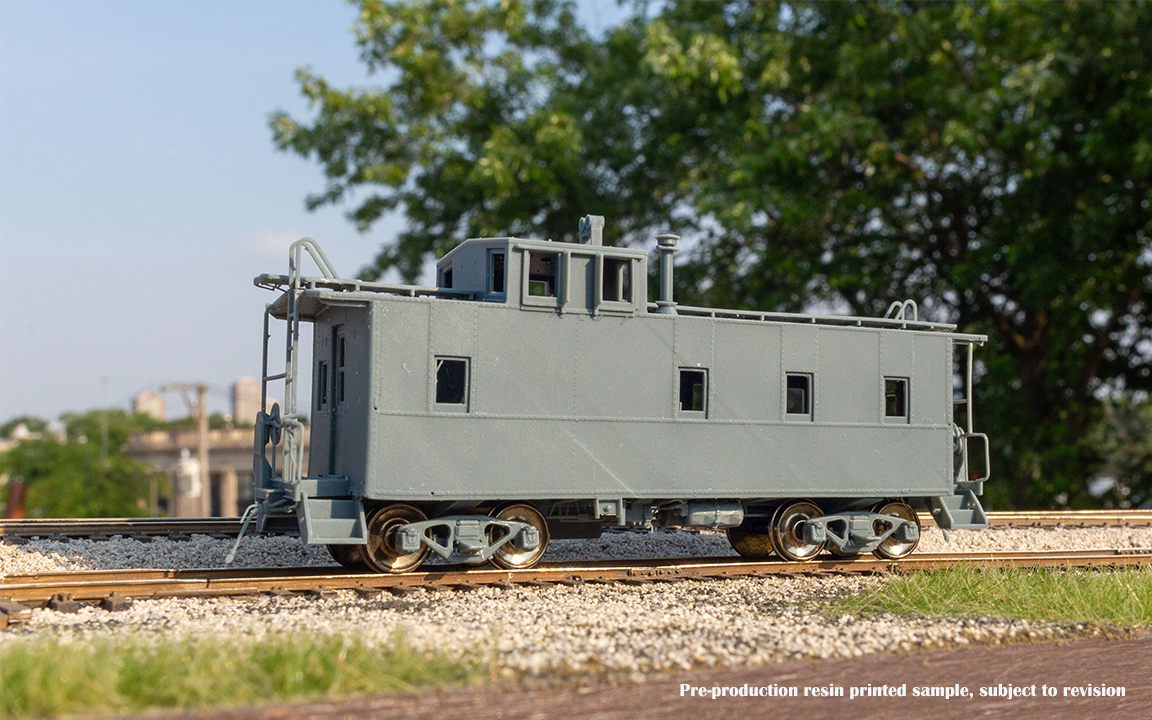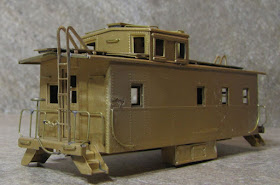 |
| Partly hidden behind other cars in the yard is the Santa Fe caboose track at Bakersfield, Calif. |
Since I've been posting about SP cabooses earlier this year, I though we should have a quick look at some of the Santa Fe "Way Cars" as they're called by Santa Fe officials. While most of my blogs have been related to modeling the SP, I do model some ATSF (Santa Fe) equipment as well because of the joint operations of the two railroads over Tehachapi Pass.
ATSF 1300-class (Wood Bodied Waycars)
These are kits and R-T-R models from Walthers with arch-bar trucks. These cars used truss rods as well, even though they had steel centersills.
ATSF 1364 - Arvin Road Switcher (Local Service)
 |
| Here's the first 1300-class cars I built, it's regularly assigned to the Arvin Road Switcher at La Mesa Model Railroad Club. |
The Arvin Branch is worked by a regular day-shift "Arvin Road Switcher" which is assigned the 1364, the "Arvin Turns" working the empties to the branch and return the loads to Bakersfield is assigned a weird steel caboose 1941. The 1941 is also used by the "Extra Arvin Switcher" which is often called to work after hours (night-shift) on the branch.
ATSF 1421 - 1st District Local & "Super Locals" (Symbols 55 & 56)
 |
| This is the second 1300-class car I built from an RTR model - Regularly assigned to the valley locals north of Bakersfield. |
Generally, I've considered these cars to be relegated to local service by the 1950s era operating sessions on the Tehachapi Sub that the La Mesa Model Railroad Club. By far the all-steel waycars were dominate after WWII, so we've tried to keep the number of 1300-class cars to a minimum.
(All Steel Waycars)
 |
| This is an example of an Intermountain "ATSF cupola way car". |
These models are easily made with Intermountain RTR or Athearn (Blue-box) RTR/kits.
Around 2005 the La Mesa Club's operating sessions were becoming desperately short of Santa Fe waycars, so I picked up four more Athearn cabooses. The Athearn models are what I've focused on making my models from because they're more economical to find.
The modifications are pretty simple with a handrail bent and fitted around the top of the cupola, a second tool box, and Tichy "Caboose trucks" with leaf-springs installed.
1500-class (Steel bodies with wood tool boxes)
This series of 150 cars were built in 1927 by ACF and numbered between 1500 and 1649 with KC brakes with vertical staff hand brakes. This series also had roofwalks in what Andy Sperandeo called Alternate Cupola Laterals arrangement. I modeled these two cars from his article in Chapter 23 of Model Railroader: Freight Car Projects & Ideas. (Published 1997 by Kalmbach)All Santa Fe waycars in these series were built with two tool boxes. The later cars need two steel boxes, so my easy solution for that is to model half the cars in the earlier series that have scratch-built wooden tool box covers.
ATSF 1579 - Road Waycar
 |
| ATSF 1579 is a basic plain Santa Fe brown waycar in post-1943 lettering without the periods in the reporting marks. |
ATSF 1563-R - Road Waycar - (Radio Equipped)
 |
| The first Santa Fe waycars fitted with radios were marked as such by a suffix "-R" after the car number. |
Unfortunately it's just out of the top of this photo, but the car is also equipped with a DTA "wagon wheel" radio antenna on top of the cupola.
1659-Class (Steel bodies with steel tool boxes - early)
This series of 90 cars (possibly 100 cars if Andy Sperandeo made a typo on the class' first car number) numbered between 1659?-1749 built in 1928.
This series had vertical staff hand brakes. The following 1750-class cars in 1929 by ACF and had Ajax hand brakes. The 1750 class cars totaled 125 cars numbered between 1750-1874. These two series of cars were built with "Alternating Cupola Laterals" which followed the earlier 1500-class cars, but now had steel tool boxes.
1875-class (Steel bodies with steel tool boxes)
This 1875-2000 series of 125 cars were built by ACF in 1930 and 1931 and had Full Cupola Laterals.These cars are basically identical to the earlier 1500-series cars above, except that they received the second steel tool box cover from the early series cars.
ATSF 1981 - Road Waycar
 |
| ATSF 1981 is a pretty plain all-steel waycar, seen here with some GP7s hanging around behind the caboose track |
The ATSF 1981 is one of my favorite way cars for a "classic" look of an "average" Santa Fe caboose from this large class of cars.
2001-Class (Last class of steel arch roof cupola waycars)
The 2001-2200 series cars were built by ACF in 1942 and had full cupola laterals and wide end lateral installed on the short end of the car.
ATSF 2164 - Road Waycar - Safety Slogan
 |
| Here's one of the Santa Fe "Safety Waycars" that Athearn produced around 2005 as an RTR model. |
My model of ATSF 2164 was one of those "Ok, I'll just get one of these and trust that Athearn got the number right!" model purchases. It was also the last of the cars at the local hobby shop at the time when I purchased these four cars to build, so I picked it up. I'm glad that no other members have bought any other odd-ball waycars like this. As too many "weird" or "rare" cars would cause indigestion of belief for operators and viewers. Better to stick with the meat and potatoes of the fleet when modeling!
Out-of-Era Notes
 |
| Here ATSF 2035 shows it's new reflector crosses along the carside and a large base-plate radio antenna up on the cupola. |
I should also mention here that there are a few tips-offs that a Santa Fe waycar is well after the steam era. One is the addition of the small Santa Fe cross-heralds along the bottom of the carside.
 |
| ATSF 999081 a CE-1 way car at Niles Canyon in 2009. Jason Hill photograph. |
Santa Fe cars in the 999000-series are of course the later rebuilds of the waycars after the 1960s, so are very much out of scope for my 1945-1955 modeling zone, and the scope of this blog post.
Other Santa Fe Waycars
Santa Fe also had some of the 1949 built 500 & 2201-class steel cars by the era I model, however these cars had peaked roofs, so I decided not to modify any of my 2005-era cars.
Santa Fe also had a number of old steel passenger combines and steel drovers cars in service after WWII until the early 1960s.
I'll also mention briefly that old passenger steel coaches were used on mail trains and other express trains. I'll probably do a blog as I start to build some old Walthers metal passenger car kits of these in the future.
In the future I'll probably touch on some later era CE-rebuilt series Santa Fe waycars and possibly the Centralia Carshop's models of these modernized cars.
Closing Thoughts
 |
| ATSF SCX-BI climbs over Tunnel 9 at the "Tehachapi Loop" with ATSF 2060 bringing up the markers. |
I hope this has touched on some options for the Santa Fe modelers out there. I'll probably be touching on some other Santa Fe models in the future as well. Part 2 will be a step by step blog on modifying an Athearn BB model.
Jason Hill
Related Links:
A trip on the Santa Fe SCX-BI during a 1950s Operations Session at LMRC
Modeling SP Cabooses (Part 1) - Ex-Coaches
Modeling SP Cabooses (Part 2) - Wooden Cupola
Modeling SP Cabooses (Part 3) - Steel Cupola











































